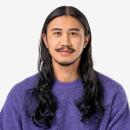Historic Filipinotown gateway to be unveiled today

- Share via
A massive arch marking the eastern entrance to Los Angeles’ Historic Filipinotown will be officially unveiled Saturday in a community celebration featuring music and dance performances and speeches from elected officials including Atty. Gen. Rob Bonta, Mayor Eric Garcetti and Councilman Mitch O’Farrell.
The Historic Filipinotown Eastern Gateway — officially called “Talang Gabay: Our Guiding Star” — spans Beverly Boulevard near the 1st Street Bridge. The 30-foot-tall, 82-foot-wide steel arch is the largest of its kind in the country, according to a news release. It is intended to serve as a monument to the Filipino American community, which is one of the largest Asian American groups in California but has never had the visibility of Chinese, Japanese or Korean populations.
“This community is so deserving of such an iconic, impressive landmark,” O’Farrell said in a recent statement. “The Historic Filipinotown Eastern Gateway pays fitting tribute to the incredible contributions of the Filipino community in Los Angeles and beyond.”
The arch, which was designed by artists Eliseo Art Silva and Celestino Geronimo Jr., features cultural symbols like the parol, a star-shaped lantern displayed by Filipinos during the Christmas season, and the gumamela, or hibiscus, flower, which is intended to pay tribute to frontline workers. It is topped with ancient mythological figures, including the sarimanok, a bird that guides the harvest seasons, and the naga, a serpent-like dragon associated with lunar and solar eclipses.
Officials said earlier in the year that the arch would contain a QR code for an online walking tour highlighting the neighborhood’s cultural landmarks.
The new arch will mark the eastern entrance to L.A.’s Historic Filipinotown, much as the twin-dragon gate over Broadway welcomes visitors to Chinatown.
The project was spearheaded by Jessica Caloza, the first Filipina American on the Los Angeles Board of Public Works, who wanted to act on the long-standing wishes of some fellow community members.
“The Historic Filipinotown Eastern Gateway project has been nearly two decades in the making,” Caloza said in a statement in April, when the arch was installed. “It’s a monument not just for the Filipino and Asian community, but for all immigrant communities who come to Los Angeles to build a life and a home.”
The celebration is set to begin at 4 p.m. with music and community booths at Beverly Boulevard and Belmont Avenue. A ribbon cutting is slated for 6:45 p.m., and the gateway lights will be turned on at 6:50 p.m. Beverly Boulevard will be closed from Union Avenue to Bixel Street for the event.
Filipino Americans settled in the area after being displaced from their original neighborhood, called Little Manila, on Bunker Hill in downtown L.A. after World War II to make way for massive redevelopment projects such as the 101 and 110 Freeways. At the time, restrictive racial covenants limited where Filipinos could live.
Historic Filipinotown is now majority Latino, with a Filipino American population of about 15%. Even so, it remains an important commercial and cultural center for Filipinos across the region.
Some community members fear that gentrification will do to Historic Filipinotown what postwar public works projects did to Little Manila, as luxury apartments are sprouting where strip malls once stood and where working-class Filipino families once lived.
Amid the changes, those who helped create the monument hope it will give a new generation of Filipino Americans a better understanding of their culture and history.
“The Talang Gabay gateway is a beautiful symbol of a neighborhood that holds great significance to Filipino Americans in Los Angeles, and we are proud to have been part of the process,” Kimmy Maniquis, executive director of the nonprofit Search to Involve Pilipino Americans, said in a recent statement. “As SIPA opens our community center on Temple Street later this year, we celebrate with the city of Los Angeles and our fellow legacy organizations in creating long-standing cultural markers that will honor the Filipino American community for generations to come.”
More to Read
Sign up for Essential California
The most important California stories and recommendations in your inbox every morning.
You may occasionally receive promotional content from the Los Angeles Times.













